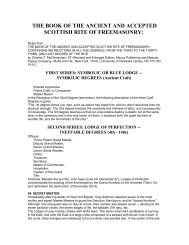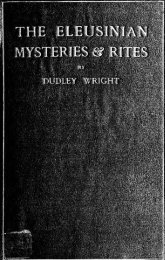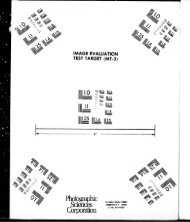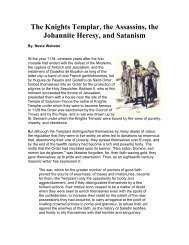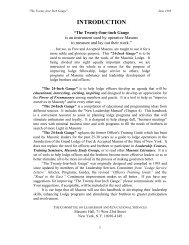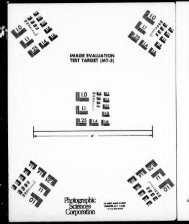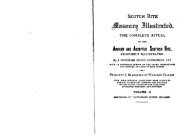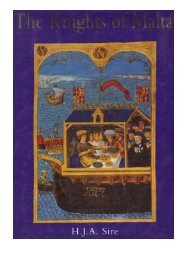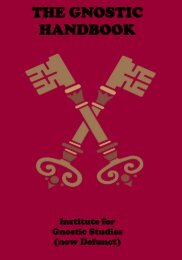The History of Initiation - The Masonic Trowel
The History of Initiation - The Masonic Trowel
The History of Initiation - The Masonic Trowel
Create successful ePaper yourself
Turn your PDF publications into a flip-book with our unique Google optimized e-Paper software.
132 HISTORY OF INITIATION.<br />
nected with them, and most frequently these places were<br />
subterranean. Few caverns in this country remain to<br />
relate the wonders <strong>of</strong> Druidical initiation ; but the stu-<br />
Eendous grotto at Castleton, in Derbyshire, 58 called by<br />
tukeley, the Stygian Cave, 59 is sufficient to convince us<br />
that these celebrations were <strong>of</strong> the most terrific nature;<br />
were performed with the aid <strong>of</strong> complicated machinery,<br />
and did not yield in interest and sublimity to those which<br />
have been so highly eulogised in the more polished and<br />
civilized nations <strong>of</strong> Egypt and Greece. <strong>The</strong>y were<br />
usually constructed on the principles <strong>of</strong> secrecy and re-<br />
vol. i., p. 166.) <strong>The</strong> husband <strong>of</strong> Isis was Osiris: a word derived,<br />
according to Vallancey, from two old Celtic words, signifying the<br />
commander <strong>of</strong> a ship or ark ; Eiss-Aire, or Is-Ir, the very name <strong>of</strong><br />
our Cumberland giant who was no other than Osiris or ; Noah, and<br />
was represented by every candidate during the initiations. Gibson,<br />
in Camden, (Col. 842,) says that this giant's cave or grotto was denominated<br />
Isis Parlish, or the cavern <strong>of</strong> Isis the perilous and the<br />
;<br />
current legend, as we have seen, is, that the monster seized men and<br />
cattle, and dragged them into his cave for a prey. <strong>The</strong> cattle were<br />
evidently brought there for sacrifice, and the men for initiation, during<br />
the process <strong>of</strong> which the aspirants were figuratively<br />
said to be<br />
devoured by the giantess Ceridwen or Isis. (Vid. infra. 1. iii.) Re-<br />
specting the giant's grave I must refer to my former volume <strong>of</strong> Signs<br />
and Symbols, Lect. VII. A similar legend is recorded by Stukeley,<br />
that a giant named Tarquin lived at Brougham Castle, in the same<br />
neighbourhood, and that Sir Lancelet du Lake, then residing at Maryborough,<br />
attacked and slew him.<br />
58<br />
Antiquities <strong>of</strong> Masonry, p. 107.<br />
59 Some very singular excavations have been discovered between<br />
Luckington and Badminster, Wilts, called the Giants' Caves, which<br />
are thus described in Childrey's Britannia Bacconica, and cited in the<br />
Aubrey MSS. **<br />
<strong>The</strong>y are upon the top <strong>of</strong> a rising hill, in number<br />
about nine and some <strong>of</strong> them are or were ; formerly cemented with<br />
lime. Some <strong>of</strong> them are deeper, and some shallower, some broader and<br />
larger than others. <strong>The</strong>y lie all together in a row <strong>The</strong> manner <strong>of</strong><br />
them is two long stones set upon the sides, and broad stones set upon<br />
the top to cover them. <strong>The</strong> least <strong>of</strong> these caves is four feet broad,<br />
and some <strong>of</strong> them are nine or ten feet long." Sir R. C. Hoare pronounces<br />
them to be ancient sepulchres ; but I conceive the learned<br />
baronet to be mistaken in this point, for the author before cited says,<br />
" the curiosity <strong>of</strong> some ingenious men, as it is reported, within these<br />
forty years, tempted them to dig into it, and make search for some<br />
ancient remains, but they found no thing but an old spur, and some few<br />
other things not worth mentioning." How could they be sepulchral<br />
if no remains were interred within them ? <strong>The</strong> fact is, they were no<br />
more sepulchral than were the pyramids <strong>of</strong> Egypt ; and I have no<br />
hesitation in saying that they were constructed for the selfsame pur-<br />
pose, viz. as places <strong>of</strong> initiation into the mysteries.



